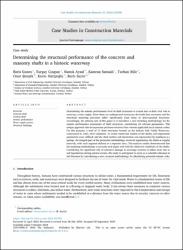| dc.contributor.author | Güneş, Barış | |
| dc.contributor.author | Coşgun, Turgay | |
| dc.contributor.author | Aysal, Namık | |
| dc.contributor.author | Samadi, Kamran | |
| dc.contributor.author | Bilir, Turhan | |
| dc.contributor.author | Şimşek, Onur | |
| dc.contributor.author | Hatipoğlu, Karsu | |
| dc.contributor.author | Sayın, Barış | |
| dc.date.accessioned | 2024-10-25T08:26:19Z | |
| dc.date.available | 2024-10-25T08:26:19Z | |
| dc.date.issued | 2024 | en_US |
| dc.identifier.citation | GÜNEŞ, Barış, Turgay COŞGUN, Namık AYSAL, Kamran SAMADİ, Turhan BİLİR, Onur ŞİMŞEK, Karsu HATİPOĞLU & Barış SAYIN. "Determining the Structural Performance of the Concrete and Masonry Shafts in a Historic Waterway". Case Studies in Construction Materials, 21 (2024): 1-30. | en_US |
| dc.identifier.uri | https://www.sciencedirect.com/science/article/pii/S2214509524009379 | |
| dc.identifier.uri | https://hdl.handle.net/11352/5106 | |
| dc.description.abstract | Determining the seismic performance level of shaft structures is crucial due to their vital role in
ensuring a water supply. Since these are underground structures, the loads they encounter and the
structural modeling processes differ significantly from those of above-ground structures.
Accordingly, the primary aim of this paper is to introduce a new modeling methodology for the
seismic performance assessment of shaft structures, considering all relevant parameters. This
unique approach also incorporates pertinent sections from various applicable local seismic codes.
For this purpose, a total of 15 shaft structures located on the historic Atik Valide Waterway,
constructed in 1583, were examined. To create numerical models of the shafts, soil exploration
parameters were utilized, and the shaft surface-soil interaction was represented by nonlinear p-y
springs. An integral part of the presented methodology involved segmenting the shafts at regular
intervals, with each segment defined as a separate story. The analysis results demonstrated that
the modeling methodology is accurate and aligns well with the observed conditions of the shafts.
Considering the significant risk of extensive damage to sewerage systems in urban areas due to
soil liquefaction during seismic events, this study is anticipated to serve as a valuable reference in
the literature by introducing a new, accurate methodology for identifying potential seismic risks. | en_US |
| dc.language.iso | eng | en_US |
| dc.publisher | Elsevier | en_US |
| dc.relation.isversionof | 10.1016/j.cscm.2024.e03786 | en_US |
| dc.rights | info:eu-repo/semantics/openAccess | en_US |
| dc.subject | Concrete Shaft | en_US |
| dc.subject | Vertical Shaft | en_US |
| dc.subject | Seismic Performance | en_US |
| dc.subject | Water Supply System | en_US |
| dc.subject | Historical Buildings | en_US |
| dc.title | Determining the Structural Performance of the Concrete and Masonry Shafts in a Historic Waterway | en_US |
| dc.type | article | en_US |
| dc.relation.journal | Case Studies in Construction Materials | en_US |
| dc.contributor.department | FSM Vakıf Üniversitesi | en_US |
| dc.identifier.volume | 21 | en_US |
| dc.identifier.startpage | 1 | en_US |
| dc.identifier.endpage | 30 | en_US |
| dc.relation.publicationcategory | Makale - Uluslararası Hakemli Dergi - Kurum Öğretim Elemanı | en_US |



















